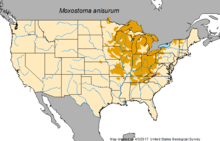Our website is made possible by displaying online advertisements to our visitors.
Please consider supporting us by disabling your ad blocker.
Silver redhorse
| Silver redhorse | |
|---|---|

| |
| Silver redhorse (Moxostoma anisurum) | |
| Scientific classification | |
| Domain: | Eukaryota |
| Kingdom: | Animalia |
| Phylum: | Chordata |
| Class: | Actinopterygii |
| Order: | Cypriniformes |
| Family: | Catostomidae |
| Genus: | Moxostoma |
| Species: | M. anisurum
|
| Binomial name | |
| Moxostoma anisurum (Rafinesque, 1820)
| |
| Synonyms | |
| |


The silver redhorse (Moxostoma anisurum: Moxostoma= mouth to suck; anisurum = unequal tail[4][5]) is a species of freshwater fish endemic to Canada and the United States.[6] It is the longest-lived redhorse known (a group of 25 extant species), with a maximum reported age of 41 years.[3] Sometimes called redhorse or sucker for short, it is in the family Catostomidae with other suckers. The species is distributed from Quebec to Alberta and is also in the Mississippi River, St. Lawrence River, Ohio River, and the Great Lakes basins. The current world record is 6.75 kilograms (14 lb 14 oz), caught by Chris Stephenson on Pickwick Lake in Alabama, April 1995[7] and certified by National Freshwater Fishing Hall of Fame. This species is of growing interest to rod-and-line anglers.[8][9] The long-lived and late-maturing silver redhorse is also a sportfish pursued by kill-and-dump bowfishing, a 21st century unregulated sport that produces tons of wanton waste, and thus management and conservation are in need of updating.[3]
- ^ NatureServe (2013). "Moxostoma anisurum". IUCN Red List of Threatened Species. 2013: e.T202159A18230929. doi:10.2305/IUCN.UK.2013-1.RLTS.T202159A18230929.en. Retrieved 20 November 2021.
- ^ "Moxostoma anisurum". NatureServe explorer. The Nature Conservancy.
- ^ a b c d Lackmann, Alec R.; Bielak-Lackmann, Ewelina S.; Jacobson, Reed I.; Andrews, Allen H.; Butler, Malcolm G.; Clark, Mark E. (2023-08-30). "Harvest trends, growth and longevity, and population dynamics reveal traditional assumptions for redhorse (Moxostoma spp.) management in Minnesota are not supported". Environmental Biology of Fishes. doi:10.1007/s10641-023-01460-8. ISSN 1573-5133.
- ^ Froese, Rainer; Pauly, Daniel (eds.). "Moxostoma anisurum". FishBase. September 2023 version.
- ^ Christopher Scharpf & Kenneth J. Lazara (3 September 2023). "Family CATOSTOMIDAE Agassiz 1850 (Suckers)". The ETYFish Project Fish Name Etymology Database. Christopher Scharpf and Kenneth J. Lazara. Retrieved 13 September 2024.
- ^ Phillips G.; Schmid W.; Underhill J. (1982). Fishes of the Minnesota Region. University of Minnesota. pp. 162–163.
- ^ "Moxostoma anisurum | Silver Redhorse". Fishing World Records.com. Retrieved 2024-09-13.
- ^ Winter, Tyler. "Trash Fish Tuesday: Redhorse". www.themeateater.com. Retrieved 2023-09-04.
- ^ "Redhorse river: Fishing for St. Croix suckers offers serious sport". St. Croix 360. 2020-05-14. Retrieved 2023-09-04.
Previous Page Next Page




